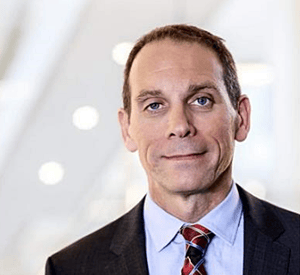Heller Search: Where were you employed before you landed at The Estée Lauder Companies as CIO?
 Michael Smith: I had a phenomenal job at Mylan. I started as the Chief Information Officer (CIO), and then they asked me to run Global Business Services (GBS), as well. As head of GBS, I was responsible for leading the company's integrated, multi-functional, global shared services, including finance, human resources and IT.
Michael Smith: I had a phenomenal job at Mylan. I started as the Chief Information Officer (CIO), and then they asked me to run Global Business Services (GBS), as well. As head of GBS, I was responsible for leading the company's integrated, multi-functional, global shared services, including finance, human resources and IT.
I came into the CIO role at Mylan with a three-year strategy fully baked, which included plans to appoint my successor. Exactly three years and one day into my role, I was able to do just that. Then, as Global Head of Digital & Innovation, I took on digital marketing, eCommerce and digital medicine, and I led transformative innovation, which is where I got my first experience running a P&L.
Why did you leave Mylan relatively soon after this promotion?
During the 3+ years I was at Mylan in Pittsburgh, PA, my family was back in Portland, OR. Although I was able to visit often, there was one weekend that influenced my decision to leave the company.
I was back in Portland, watching my son compete in a wrestling match that ultimately landed him at the state championships. Due to some work commitments, I had to miss watching him compete in the state championship, which got me thinking about what was important.
So I decided that the best thing for me and my family at the time was to resign from Mylan and take a one year sabbatical so that I could be present for my son’s senior year in high school. It was a special year for me and especially for my son.
What did you do during your sabbatical?
My family and I traveled a lot. I joined three advisory boards, delivered keynotes at multiple C-level conferences across North America, mentored a number of executives and did some consulting work.
How did the Estée Lauder CIO opportunity arise?
Believe it or not, just a couple weeks after I had resigned from Mylan, I got a call from a recruiter telling me that the CIO at Estée Lauder was planning to retire. The recruiter told me all about the company and the role, and it sounded like an exciting opportunity. It got me thinking that, one day, I may want to get back to a consumer-focused company, to retail and prestigious consumer brands. Prior to joining Mylan, I had spent 22 years at Nike.
But I was committed to my sabbatical plan, and I told the recruiter to call me if the job was still available in a year, although I knew it’d be unlikely. But just under a year later, I heard that the CIO position at Estée Lauder was indeed still open and I called to put my name back for consideration. I accepted an offer one year to the day after starting my sabbatical.
Besides the consumer brands focus, what else piqued your interest?
I get excited about working with great leaders and great leadership teams - visionaries who want to transform their industries, who aspire to inspire. I had the privilege to work with some pretty impressive and visionary leaders up to that point, like Phil Knight at Nike, although I never reported directly to him, Mark Parker at Nike and Heather Bresch at Mylan. Everything I heard and read about Fabrizio Freda, President and Chief Executive Officer of Estée Lauder, placed him in this league of dynamic, engaged, curious CEOs.
What did Estée Lauder find attractive about your background?
I have a strong track record for leading transformation, and a lot of experience with digital marketing and innovation in areas like eCommerce and mobile, such as my work with Nike ID. I ran Nike.com, Nike+ and NikeFuel, the fitness tracking ecosystem. Also, I had done a lot with analytics both at Nike and at Mylan.
Estée Lauder liked that I wasn’t just all IT. At Nike, I started in IT and ended in IT, but I did a lot of other things outside of IT in the middle. At Mylan, I led several global business services during a time when the company went through tremendous growth.
I think they also appreciated the fact that I had experience in different industries, including pharma, retail and fashion. There are a lot of similarities between Nike and Estée Lauder. For example, at Mylan we owned a vast majority of our own manufacturing and R&D, which Estée Lauder does as well.
Did you have an interview strategy, and how did you prepare?
My interview strategy was simply to “be authentic.” I didn’t spend a lot of time thinking about the questions they would ask, because I thought it would be more genuine to be on-the-fly. I wanted the job, but I thought it was important that they want me for who I am and the experiences I could offer.
That being said, I prepared for my interviews by learning about the company and the leadership team. I read about the company as much as I could and I also went to a few cosmetics counters at department stores to see how people interacted with me. I went to Ulta and Sephora stores because I wanted to know about the products and the consumer experience. And during my travels, I was able to experience Estée Lauder’ Travel Retail, as well.
Was there anything particularly memorable about the interview process?
It is a robust and thorough interview process, which gave me a good sense for the company, its people and its values. What impressed me then, and still does, is that people really want you to understand the company and what makes it tick.
What makes Estée Lauder tick?
People here want you to be successful. We’re a relationship-driven company. In some organizations, pushing transformational ideas can feel like an obstacle course. Not here. People are helping you to be successful.
Were you asked about your sabbatical?
During the interview process, I was asked what I learned during my sabbatical. I realized that I had not reflected on that question, and it caught me a bit off guard. I can’t remember exactly how I answered the question, but I have thought about it since then.
First, I realized that serving on the advisory boards of various technology companies during my sabbatical provided me a new perspective on the technology industry, which has been very valuable for me in my new role.
Second, and the more profound one I believe, is that I missed being in the middle of it all. Going full tilt. This work is a big part of what drives me as a person. I view my career as an opportunity to make things better - better for consumers, better for our employees, especially the people I have the privilege to lead. I would not trade one moment of my year off and the time I was fortunate enough to spend with my family for anything, but I also realize that my profession is my calling.
How did you prepare to start your CIO role at Estée Lauder?
I did a lot more competitor research. Before, I was focused on Estée Lauder but once I accepted my offer, I doubled down on understanding our competitors.
Who do you report to?
Tracy T. Travis, Executive Vice President and Chief Financial Officer
Since starting, what have you and your leadership team been working on?
We have reset our IT function strategy quite significantly – how we are going to operate in IT going forward, so that we can be more agile and more consumer focused. We also reset our technology strategy and we’re building on the solid technology foundation that we have and responding to the dynamic nature of our business.
What do you mean by the ‘dynamic nature of our business?’
Consumer expectations are always rising and changing. As we see each new generation of consumers come along, they bring new expectations. And not just with regard to retail, but also in the workplace – such as the tools our employees expect to have to do their jobs. There are also broader geopolitical shifts we must track and respond to. For example, as Asia continues to significantly influence prestige beauty, our success will depend on how nimble and agile we are to respond to and influence trends in our industry.
Have you made changes to the IT organization?
When I joined the company, I only had two direct reports, and everyone else in IT was underneath those two. We have de-layered the organization so we can be even more integrated.
We are also placing a stronger emphasis on relationships between IT and our brands. Technology can be a major competitive advantage and we want our brands to have access to the best resources to build the most exciting and aspirational consumer experiences.
It is an exciting time. This is an amazing team, but I can’t take the credit for that. That credit goes to my predecessor and the many people who have supported IT at Estée Lauder.
What does digital transformation mean at Estée Lauder?
I try not to use the words “digital transformation.” You will not see it anywhere in my strategy or my presentations because it can mean so many different things to different people. Our tech strategy is taking into account all the major emerging technologies. So while we are doing it, for certain, I don’t use the phrase “digital transformation.”
How do you know when your IT organization is succeeding?
Every strategy has a set of actions and a set of success metrics. Those metrics alone will tell me whether or not we are succeeding on a measurement basis. But metrics can be deceiving. I also want to hear feedback from leadership and our consumers. I want to see that new capabilities are following through on the business case: Are they generating the revenue we said they would? The profit? The cost savings? The experience? So, it is a combination of metrics, feedback and following through on the business cases.
How do you attract and retain top IT talent?
One of our goals is to be the highest performing IT organization in the industry, and I believe we will be. To do that, we need to be a destination for where people want to come to work, and we are doing a lot to attract people, like flexible work arrangements. In the New York City area, we are going from having IT located in many different buildings to a new, innovative, highly-connected two-campus model.
We are opening a brand new tech hub in Long Island City (LIC) in August 2018. We renovated the new space and we’re building a world class collaboration workplace for our IT employees, with a fully staffed gym, cafeteria and a ton of other amenities. It is going to be an amazing place for people to come work. LIC is an up-and-coming neighborhood and is the home of a bunch of tech startups, new restaurants and pubs, art installations and new apartment developments.
If you look at our consumers, they are predominantly female. So, I think we have every right to be the destination of choice for women in technology. We are putting a significant focus on female recruitment and we are also sponsoring events such as the Grace Hopper Conference and hosting hackathons focused on women. People who love our products and what we stand for as a company should want to come work for us.
What is your favorite place to travel on business?
I love Shanghai. I have loved travelling there since my Nike days, when the company made a big commitment there 10-15 years ago. We knew then about the big influence that China was going to have. I enjoy the energy in Shanghai. There is an optimism. I don’t know that you see a lot of innovative technology, but there is a lot of innovative application of technology, and so many people starting up businesses. The optimism in Shanghai is palpable.
What advice do you have for an IT executive thinking about entering the job market?
You have to know where your passion lies, and you should never settle for an opportunity that doesn’t play to your passions. It‘s easy to jump at money or a title, or even a brand. One of my favorite quotes is by Andrew Carnegie: “My heart is in the work.” If you don’t have passion for your work, you are not going to be happy.
A new job is a huge decision. It is not irreversible, but before you go searching, you need to know what you are searching for. Do you want to focus on developing people? Transforming an industry? Maybe you like operations and simply running IT, and that is perfectly fine. But you have to know what that is.
My twitter handle is @lifeworkpassion, the blending of all three, so this is obviously something I strongly believe!
About Michael Smith
Michael Smith is Chief Information Officer at The Estée Lauder Companies Inc. (NYSE:EL). For more than 25 years, Smith held various technology leadership positions, including four years with Mylan NV, a global pharmaceuticals company, where he was Global Head of Digital and Innovation and Global Business Services. He also spent 22 years with Nike, Inc. in multiple brand and technology roles, including Senior Director, Brand Product and Marketplace Solutions and Senior Director, Enterprise Solutions and Technology. Smith is currently a member of multiple advisory boards, including ACCOY Pharmaceuticals, a healthcare company; CausePoint a technology company; and Incture, a software company.
About The Estée Lauder Companies
The Estée Lauder Companies Inc. is one of the world’s leading manufacturers and marketers of quality skin care, makeup, fragrance and hair care products. The company’s products are sold in over 150 countries and territories under brand names including: Estée Lauder, Aramis, Clinique, Prescriptives, Lab Series, Origins, Tommy Hilfiger, M·A·C, Kiton, La Mer, Bobbi Brown, Donna Karan New York, DKNY, Aveda, Jo Malone London, Bumble and bumble, Michael Kors, Darphin, Tom Ford, Smashbox, Ermenegildo Zegna, AERIN, Tory Burch, RODIN olio lusso, Le Labo, Editions de Parfums Frédéric Malle, GLAMGLOW, By Kilian, BECCA and Too Faced.

Written by Steve Rovniak
Steve Rovniak served as Executive Director, Marketing and Media at Heller Search Associates from 2012 to 2023.



